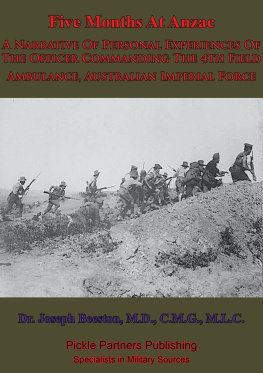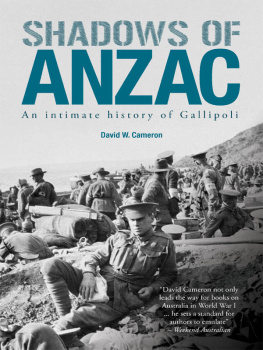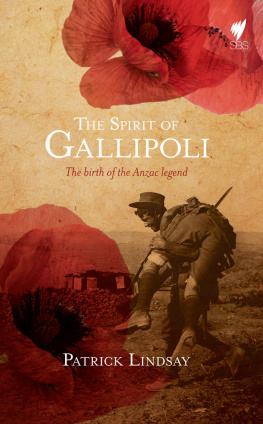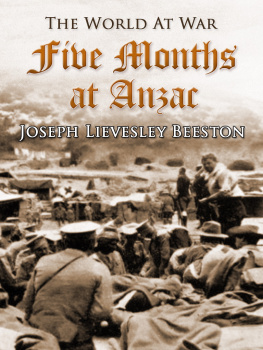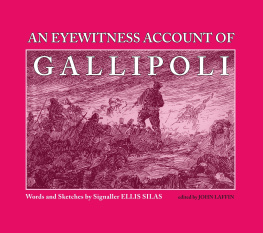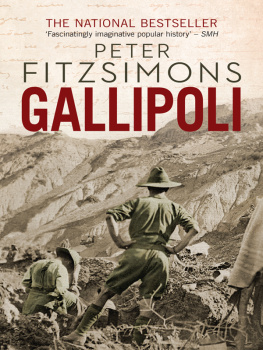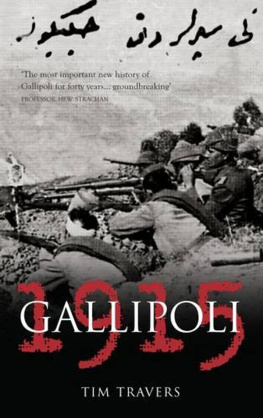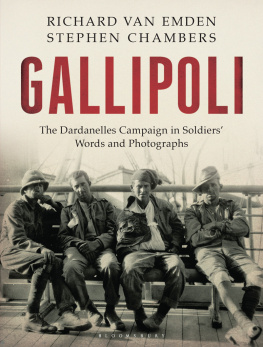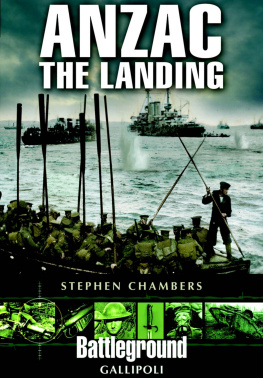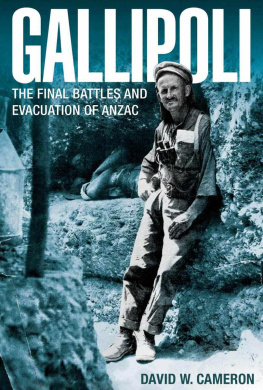

This edition is published by PICKLE PARTNERS PUBLISHING www.picklepartnerspublishing.com
To join our mailing list for new titles or for issues with our books
Or on Facebook
Text originally published in 1916 under the same title.
Pickle Partners Publishing 2013, all rights reserved. No part of this publication may be reproduced, stored in a retrieval system or transmitted by any means, electrical, mechanical or otherwise without the written permission of the copyright holder.
Publishers Note
Although in most cases we have retained the Authors original spelling and grammar to authentically reproduce the work of the Author and the original intent of such material, some additional notes and clarifications have been added for the modern readers benefit.
We have also made every effort to include all maps and illustrations of the original edition the limitations of formatting do not allow of including larger maps, we will upload as many of these maps as possible.
FIVE MONTHS AT ANZAC
A NARRATIVE OF PERSONAL EXPERIENCES OF THE OFFICER COMMANDING THE 4th FIELD AMBULANCE, AUSTRALIAN IMPERIAL FORCE
By
JOSEPH LIEVESLEY BEESTON
C .M.G., V.D., L.R.C.S.I., Colonel A.A.M.C. Late O.C. 4th Field Ambulance, late A.D.M.S. New Zealand and Australian Division
TABLE OF CONTENTS
Contents
DEDICATION
DEDICATED TO
THE OFFICERS, NON-COMMISSIONED OFFICERS AND MEN OF THE 4th FIELD AMBULANCE, A.I.F., OF WHOSE LOYALTY AND DEVOTION TO DUTY THE WRITER HEREBY EXPRESSES HIS DEEP APPRECIATION.

ANZAC COVE.
Photo by Lieut.-Col. Millard.
FOURTH FIELD AMBULANCE
Shortly after the outbreak of Warafter the first contingent had been mobilised, and while they were undergoing trainingit became evident that it would be necessary to raise another force to proceed on the heels of the first. Three Infantry Brigades with their Ambulances had already been formed; orders for a fourth were now issued, and naturally the Ambulance would be designated Fourth Field Ambulance.
The Fourth Brigade was composed of the 13th Battalion (N.S.W.), 14th (Victoria), 15th (Queensland) and 16th (Western Australia)commanded respectively by Lieutenant-Colonel Burnage, Lieutenant-Colonel Courtnay, Lieutenant-Colonel Cannon and Lieutenant-Colonel Pope. The Brigade was in charge of Colonel Monash, V.D., with Lieutenant-Colonel McGlinn as his Brigade Major.
As it will be necessary from time to time to allude to the component parts of the Ambulance, it may be as well to describe how an ambulance is made up. It is composed of three sections, known as A, B, and C, the total of all ranks being 254 on a war strength. It is subdivided into Bearer, Tent and Transport Divisions. Each section has its own officers, and is capable of acting independently. Where there is an extended front, it is frequently desirable to detach sections and send them to positions where the work is heaviest.
As the name implies, the Bearers convey the wounded to the dressing station (or Field Hospital, as the case may be). Those in the Tent Division dress the cases and perform nursing duties, while the Transport Division undertakes their conveyance to Base Hospital.
It was decided to recruit the Fourth Field Ambulance from three States, A Section from Victoria, B from South Australia, C from Western Australia. Recruiting started in Broadmeadows, Victoria, on the 19th October, 1914, and thirty men enrolled from New South Wales were included in A Section. Towards the end of November B Section from South Australia joined us, and participated in the training. On the 22nd December we embarked on a transport forming one of a convoy of eighteen ships. The nineteenth ship joined after we left Albany.
Details from the Ambulance were supplied to different ships and the officers distributed among the fleet. Our last port in Australia was Albany, which was cleared on the last day of 1914a beautiful night and clear day, with the sea as smooth as the proverbial glass.
THE VOYAGE
The convoy was under the command of Captain Brewisa most capable and courteous officer, but a strict disciplinarian. To a landsman, his control of the various ships and his forethought in obtaining supplies seemed little short of marvellous. I had the good fortune to be associated with Captain Brewis on the passage from Colombo to Alexandria on board the and his friendship is a pleasant memory.
The fleet was arranged in three lines, each ship being about three lengths astern of the one ahead. The sight was most inspiriting, and made one feel proud of the privilege of participation. The towed the submarine AE2, and kept clear of the convoy, sometimes ahead, then astern, so that we viewed the convoy from all points.
The day after leaving Albany a steamer, which proved to be the , joined us with C Section of our Ambulance. Signals were made for the to move ahead and the to drop astern, the moving into the vacant place. The manoeuvre was carried out in a most seamanlike manner, and Captain Young of the received many compliments on his performance.
Three days later a message was flagged from the that Major Stewart (who commanded the C Section of the Ambulance) was ill with enteric, and that his condition was serious. The flagship then sent orders (also by flag) Colonel Beeston will proceed to and will remain there until next port. to provide transport. A boat was hoisted out, and Sergeant Draper as a nurse, Walkley my orderly, my little dog Paddy and I were lowered from the boat deck. What appeared smooth water proved to a long undulating swell; no water was shipped, but the fleet at times was not visible when the boat was in the trough of the sea.
However, the was manoeuvred so as to form a shelter, and we gained the deck by means of the companion ladder as comfortably as if we had been in harbour. Major Stewarts illness proved to be of such a nature that his disembarkation at Colombo was imperative, and on our arrival there he was left in the hospital.
The heat in the tropics was very oppressive, and the horses suffered considerably. One day all the ships carrying horses were turned about and steamed for twenty minutes in the opposite direction in order to obtain a breath of air for the poor animals. In the holds the temperature was 90 and steamy at that. The sight of horses down a ships hold is a novel one. Each is in a stall of such dimensions that the animal cannot be knocked about. All heads are inwards, and each horse has his own trough. At a certain time in the day lucerne hay is issued. This is the signal for a prodigious amount of stamping and noise on the part of the animals. They throw their heads about, snort and neigh, and seem as if they would jump over the barriers in their frantic effort to get a good feed. Horses on land are nice beasts, but on board ship they are a totally different proposition. One intelligent neddy stabled just outside my cabin spent the night in stamping on an adjacent steam pipe; consequently my sleep was of a disturbed nature, and not so restful as one might look for on a sea voyage. When he became tired, the brute on the opposite side took up the refrain, so that it seemed like Morse signalling on a large scale.
We reached Colombo on the 13th January, and found a number of ships of various nationalities in the harbour. Our convoy almost filled it. We were soon surrounded by boats offering for sale all sorts of things, mostly edibles. Of course no one was allowed on board.
Next page
